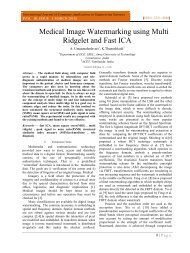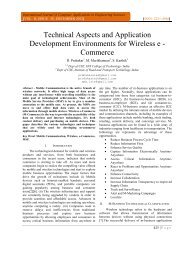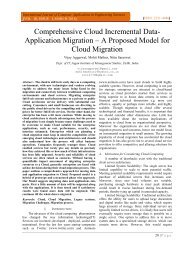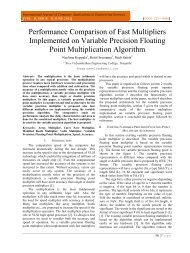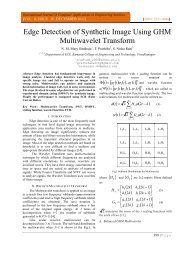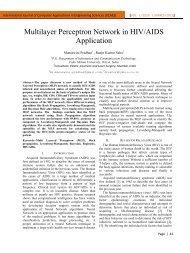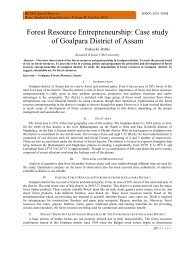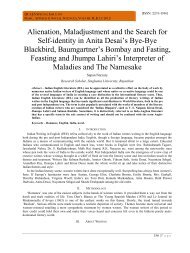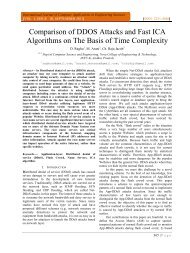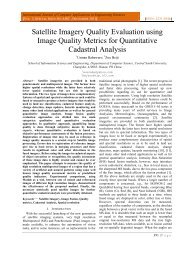Ficus Species and its Significance - International Journal of ...
Ficus Species and its Significance - International Journal of ...
Ficus Species and its Significance - International Journal of ...
You also want an ePaper? Increase the reach of your titles
YUMPU automatically turns print PDFs into web optimized ePapers that Google loves.
<strong>International</strong> <strong>Journal</strong> <strong>of</strong> Computer Applications in Engineering Sciences<br />
[VOL II, ISSUE III, SEPTEMBER 2012] [ISSN: 2231-4946]<br />
<strong>Ficus</strong> <strong>Species</strong> <strong>and</strong> <strong>its</strong> <strong>Significance</strong><br />
Sajida Begum 1 , I. C. Barua 2<br />
1 Research Scholar, Singhania University<br />
2 Principal Scientist Assam Agriculture University, Jorhat , Assam<br />
Abstract—There is great importance <strong>of</strong> the genus <strong>Ficus</strong><br />
among the living beings since time immemorial. Besides<br />
aesthetic <strong>and</strong> religious values, many species <strong>of</strong> this genus<br />
are in use in day to day life as food <strong>and</strong> in traditional<br />
medicine. The present study, spanning from 2007 to<br />
2011,unfurled many species having socio-culturally<br />
intrinsic relations with the Assamese people notable among<br />
them are F.religiosa, F. bengalensis, F.hispida, F. racemosa<br />
,F curtipes, F rumphi, F. elastica <strong>and</strong> so on any species<br />
have great commercial potentials <strong>and</strong> these species need<br />
proper value addition.<br />
Keywords—<strong>Ficus</strong> species, aesthetics, medicinal values,<br />
commercial potentials.<br />
I. INTRODUCTION<br />
From time immemorial, many medicinal plants<br />
were well known in India. Use <strong>of</strong> herbal medicine can<br />
be traced to the remote past. In Rig Veda (4500 B.C. -<br />
1000 B.C.), healing properties <strong>of</strong> some herbs are<br />
mentioned in the form <strong>of</strong> sonnets, which were <strong>of</strong>ten<br />
recited in religious rituals.<br />
Charakas treaties described 1500 plants <strong>and</strong><br />
identified 350 <strong>of</strong> them as valuable for medicinal<br />
purposes (Patnaik, 1993). During the glorious days <strong>of</strong><br />
Buddha philosophy (600 BC- 400 AD), there was a<br />
friendly mingling <strong>of</strong> therapeutic values <strong>of</strong> plants<br />
through religious norms were different. Scholars<br />
practicing medicine were quite familiar with wild<br />
medicinal plants growing in jungles. (Joshi- 2000)<br />
The oldest living plant <strong>of</strong> known planting date is<br />
a Peepal tree known as the Sri Moha Bodhi planted in<br />
the temple Sri Lanka (At Anuradhapuram) by king Tissa<br />
in 288 B.C.<br />
Gautam Buddha is traditionally held to have<br />
found enlightenment while meditating under a sacred<br />
fig tree. It is also one <strong>of</strong> the two sacred trees <strong>of</strong> Islam. In<br />
East Asia, figs are pivotal in Buddhism, Hinduism <strong>and</strong><br />
Jainism.<br />
The plant is <strong>of</strong>ten found in old temple complexes.<br />
The vast shady expanse beneath the tree makes it a<br />
popular gathering spot in many villages <strong>of</strong> India as well<br />
as Assam. This tree considered as God. In Folklore<br />
beliefs Aswathama, son <strong>of</strong> Dronacharya transformed<br />
into a Peepal tree (Sharma, Dr N, 1995).<br />
Various tribes, sub-tribes <strong>and</strong> races <strong>of</strong> the great<br />
Assamese society have valued several species <strong>of</strong> <strong>Ficus</strong><br />
in their own way. As the genus is rich in diversity, this<br />
region possesses tremendous scope <strong>of</strong> exploitation <strong>of</strong> <strong>its</strong><br />
members, as many species belonging to this genus have<br />
carried good properties for uses for the benefit <strong>of</strong><br />
mankind. With an aim to find out various uses <strong>of</strong> <strong>Ficus</strong><br />
species in the Assamese society, this ethno-botanical<br />
study was initiated. It has great commercial potentials.<br />
II.<br />
MATERIALS AND METHODS<br />
The study area was the Brahmaputra valley <strong>of</strong><br />
Assam. The study was initiated in the year 2007.<br />
Different places <strong>of</strong> Assam were visited <strong>and</strong> people <strong>of</strong><br />
different tribes <strong>and</strong> races were interviewed. Voucher<br />
specimens were collected, thoroughly studied in respect<br />
<strong>of</strong> their morphology <strong>and</strong> identified with the help <strong>of</strong><br />
published literature, <strong>and</strong> Botanical Survey <strong>of</strong> India,<br />
Eastern Circle, Shillong.<br />
III.<br />
RESULTS AND DISCUSSION<br />
<strong>Ficus</strong> (Moraceae) is one <strong>of</strong> the largest genera<br />
occurring in Assam <strong>and</strong> is represented by nearly 60 taxa<br />
under 50 species. Since long past many species <strong>of</strong> this<br />
genus are associated with people. <strong>Ficus</strong> religiosa, F.<br />
elastica, F. benghalensis, F. rumphi, etc. are well known<br />
for their aesthetic as well as medicinal values. This<br />
information <strong>of</strong> <strong>Ficus</strong> species collected during the<br />
investigation are discussed below:<br />
A. <strong>Ficus</strong> Altissima Blume<br />
Vern. Name: Dhup, (Asm.).<br />
A large tree. Leaves are ovate-elliptic or ovatelanceolate,<br />
entire, obtuse <strong>and</strong> coriaceous. Hypenthodia<br />
are sessile, in axillary pairs, yellow when ripe.<br />
The plant is <strong>of</strong>ten conserved as avenue tree in<br />
roadsides <strong>and</strong> temple premises, <strong>and</strong> considered as sacred<br />
tree by Assamese Hindus. A red dye is also obtained<br />
from the decoction <strong>of</strong> <strong>its</strong> barks mixing with lime<br />
(Kanjilal et al., 1940).<br />
B. <strong>Ficus</strong> benghalensis L<br />
Vern. Name: Bor (Asm.); Indian Banyan Tree (Eng.)<br />
This plant has a special place in the Indian<br />
culture <strong>and</strong> is believed as a sacred tree. It is very <strong>of</strong>ten<br />
found in old temple complexes, road sides <strong>and</strong> other<br />
public places as well as in forests throughout the state.<br />
The hanging roots are anti-emetic. The paste prepared<br />
from the bark is applied in cuts <strong>and</strong> wounds <strong>and</strong> joint<br />
paints<br />
1) <strong>Ficus</strong> Curtipes Corner, Gard<br />
Vern. Name: Kotholua-jori; Kothal-potia-bor (Asm).<br />
273 | P a g e
Begum et. al.<br />
A large tree usually starts as epiphyte, glabrous<br />
throughout. Leaves are oblong-elliptic or obovate<br />
elliptic <strong>and</strong> thickly coriaceous. Hypenthodia are<br />
globose, sessile <strong>and</strong> axillary.<br />
Leaves are used by the Mishings for fermenting<br />
liquor to make the liquor clear <strong>and</strong> light, in preparing<br />
their traditional country liquor “Apong”. The leaves are<br />
also cooked with pork.<br />
2) F. elastica R0xb.ex Hornem.<br />
Ven name-Rubber gach<br />
A big <strong>and</strong> glabrous tree. Leaves are ellipticoblong,<br />
abruptly caudate <strong>and</strong> coriaceous.<br />
The plant is cultivated as ornamental tree. Young<br />
red shoots are eaten cooked.Latex are used to treat intes<br />
tinal worms.4. <strong>Ficus</strong> heterophylla L.<br />
Vern. Name: Konai dimoru (Asm.).<br />
A creeping <strong>and</strong> trailing much branched hispid<br />
sc<strong>and</strong>ent shrub with axillary solitary hypenthodia.<br />
The plant is commonly cultivated ornamental<br />
trailer on walls or tree trunks. Its bark <strong>and</strong> root powder<br />
is medicinal in cough, asthma <strong>and</strong> chest pain (Dutta,<br />
2006) <strong>and</strong> Assamese people administered it mixing with<br />
cori<strong>and</strong>er.<br />
3) <strong>Ficus</strong> hirta Vahl.<br />
Vern. Name: Khongal dimoru (Asm.)<br />
A rusty-pubescent shrub with hollow stem <strong>and</strong><br />
broad-ovate leaves. Hypenthodia are axillary, in pairs,<br />
globose <strong>and</strong> tomentose. The plant is common in upper<br />
Assam <strong>and</strong> hilly districts.<br />
Its ripe fru<strong>its</strong> are eaten fresh <strong>and</strong> very young top<br />
shoots are cooked by Mishings.<br />
4) <strong>Ficus</strong> hispida L.<br />
Vern. Name: E0a Dimoru (Asm.);<br />
A small to medium sized tree with hollow<br />
branches, obovate to elliptic serrate leaves <strong>and</strong> paired or<br />
clustered hypenthodia. The plant is quite common<br />
throughout the state with somewhat weedy nature.<br />
The green figs are cooked as vegetables <strong>and</strong><br />
ripe figs are eaten fresh. Both figs <strong>and</strong> leaves possess<br />
antidiabetic properties. Leaves are cooked with pork by<br />
Mishings <strong>and</strong> Thengal Kacharis. Mishings also use <strong>its</strong><br />
leaves for fermenting their country liquor “Apong”.<br />
Boro people believe that feeding ripe fru<strong>its</strong> to mothers<br />
promote milk secretion.<br />
Roots <strong>and</strong> leaves are known as antidiarrhoeal<br />
(Subhash & M<strong>and</strong>al 2002), antidiabetic (Ghosh &<br />
Sharotch<strong>and</strong>ra, 2004) <strong>and</strong> cardioprotective<br />
(Shanmugarjan & Arunsunda, 2008). A mixture <strong>of</strong><br />
honey <strong>and</strong> the juice <strong>of</strong> these fru<strong>its</strong> is a good<br />
antihemorrhagic (Nadkarni, 1996).<br />
5) 7. <strong>Ficus</strong> racemosa L.<br />
Vern. Name: Gular (Hindi.); Jagya-dimoru (Asm.)<br />
The plant is a large deciduous tree. Hypenthodia<br />
are pyriform, large, peduncled, in short panicled<br />
fascicles on the trunk.<br />
The leaves <strong>and</strong> young shoots are eaten cooked by<br />
Mishings. Ripe hypenthodia are eaten fresh by many.<br />
Leaves are used as fodder. Hypenthodia <strong>and</strong> leaves are<br />
also used in many religious functions <strong>of</strong> Assamese<br />
Hindus.<br />
Tender fru<strong>its</strong> are astringent, stomachic,<br />
refrigerant, <strong>and</strong> also administered in dry cough, burning<br />
sensation, fatigue (Ch opra et al., 1992). It is one <strong>of</strong> the<br />
popular trees in indigenous Indian System <strong>of</strong> Medicine<br />
(ISM) like Ayurveda <strong>and</strong> <strong>its</strong> various parts are used in<br />
dysentery, diarrhoea, diabetes, bilious affections,<br />
menorrhage, hymoptysis, piles, etc. (Paarakh, 2009).<br />
6) 8. <strong>Ficus</strong> religiosa L.<br />
Vern. Name: Aanhot (Asm.); Pipal-tree (Eng.)<br />
A large deciduous tree. Leaves are used in<br />
marriage ceremony <strong>and</strong> some other religious functions<br />
<strong>of</strong> Hindus in Assam. Leaves are also used as fodder. The<br />
bark is astringent. The seeds are cooling <strong>and</strong> the fru<strong>its</strong><br />
are laxative. The leaves <strong>and</strong> young shoots are given as<br />
purgative. The bark is used for tanning<br />
9. F. rumphi Vern. Name: Jori; (Asm).<br />
A large deciduous tree. Leaves are ovate,<br />
acuminate <strong>and</strong> glabrous. Hypenthodia are sessile, ovoid,<br />
in axillary pairs. The plant is quite common in road<br />
sides, open-places <strong>and</strong> forests, <strong>and</strong> sometimes appears<br />
as industrial weed.<br />
Leaves are good fodder, <strong>and</strong> used in treating<br />
mouth diseases <strong>of</strong> cattle in Assam. Fruit juice is<br />
medicinal in asthma <strong>and</strong> prescribed with black-pepper,<br />
turmeric <strong>and</strong> ghee (Dutta, 2006). Lac insects are reared<br />
on this tree (Kanjilal et al., 1940; Dutta, 2006).<br />
IV. CONCLUSION<br />
From the above discussion, it can be understood<br />
that <strong>Ficus</strong> have great significance among the people <strong>of</strong><br />
Assam. Other than aesthetic <strong>and</strong> religious value, it has<br />
medicinal <strong>and</strong> food value as well. <strong>Ficus</strong> species have<br />
therapeutic value <strong>and</strong> are used by different tribes <strong>and</strong><br />
races <strong>and</strong> rural inhabitants <strong>of</strong> Assam.<br />
The total number <strong>of</strong> plants species in the world is<br />
more than 3,00,000. India has lost more than 78% <strong>of</strong> <strong>its</strong><br />
forests (World Resource Institute, 1992). Most <strong>of</strong> the<br />
wild species <strong>of</strong> <strong>Ficus</strong> <strong>of</strong> Assam are threatened by human<br />
pressure. These trees must be protected <strong>and</strong> conserved<br />
for existence <strong>of</strong> the rich socio culture <strong>of</strong> the great<br />
Assamese society. Some <strong>of</strong> them need further value<br />
addition since they have great commercial potentials.<br />
REFERENCES<br />
[1] Chopra, R. N., Nayar, S. L. & Chopra, I. C. (1992). Gossary <strong>of</strong><br />
Indian Medicinal Plants (Repr. Edn.). CSIR, New Delhi.<br />
274 | P a g e
<strong>Ficus</strong> <strong>Species</strong> <strong>and</strong> <strong>its</strong> <strong>Significance</strong><br />
[2] Dutta, A. C. (2006). Dictionary <strong>of</strong> Economic <strong>and</strong> Medicinal<br />
Plants (Rev. edn.). Jorhat, Assam.<br />
[3] Ghosh, R. & Sharotch<strong>and</strong>ra, R. S. (2004). Hypoglycemic<br />
activity <strong>of</strong> <strong>Ficus</strong> hispida in normal <strong>and</strong> diabetic albino rats. Ind.<br />
J. Pharmacol. 36: 222-225.<br />
[4] Kanjilal, U. N., Kanjilal, P. C., De, R. N. & Das, A. (1940) Flora<br />
<strong>of</strong> Assam. Govt. <strong>of</strong> Assam. Shillong.<br />
[5] Nadkarni, K. M. (1996). <strong>Ficus</strong> hispida <strong>and</strong> <strong>Ficus</strong> daemona. In<br />
Indian Materia Medica. (Ed. Nadkarni, K. M. & Nadkarni, A.<br />
K.) 2nd ed. Vol-1. Popular Prakashan Pvt. Ltd., Mumbai. pp.<br />
550-551.<br />
[6] Paarakh, P. M. (2009). <strong>Ficus</strong> racemosa Linn.- An overview. Natl.<br />
Product Radiance 8(1): 84-90.<br />
[7] Rao, R. R. (1994). Biodiversity in India. Bishen Singh Mahendra<br />
Pal Singh, Dehra Dun.<br />
[8] Shanmugarjan, T. S. & Arunsunda, M. C. (2008).<br />
Cardioprotective effect <strong>of</strong> <strong>Ficus</strong> hispida Linn. on<br />
cyclophosphamide provoked oxidative myocardial injury in a rat<br />
model. Intern. J. Pharmacol 2008: 1-10.<br />
[9] Subhash, C. & M<strong>and</strong>al, C. K. (2002) Studies on anti-diarrhoeal<br />
activity <strong>of</strong> <strong>Ficus</strong> hispida leaf extract in rats. Fitotherapia 73: 663-<br />
667.<br />
[10] Patnaik, Nabeen (1993): The Garden <strong>of</strong> Life, An introduction to<br />
the healing plants <strong>of</strong> India. Aquarian: An imprint <strong>of</strong> Harper<br />
Collins Pulishers<br />
[11] Sharma, Dr N. C.(1995): Axamiya Loka Samskritira Abhasa,<br />
published by Bani Prakash Pvt. Ltd.<br />
275 | P a g e



